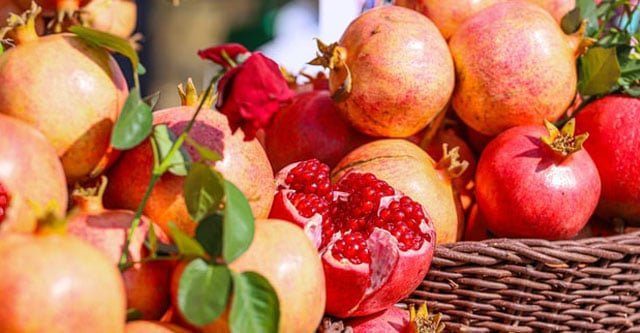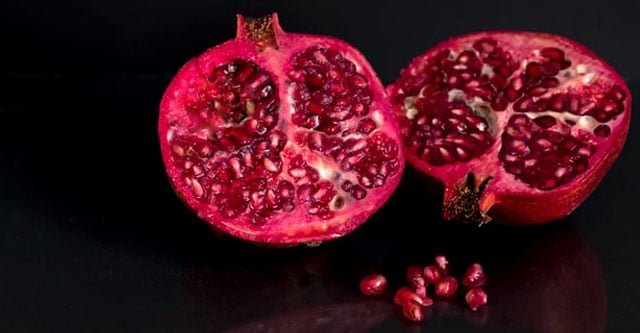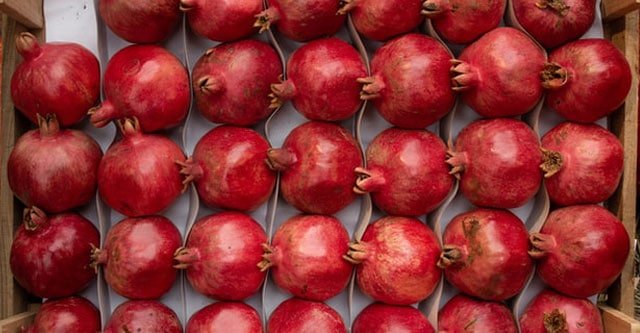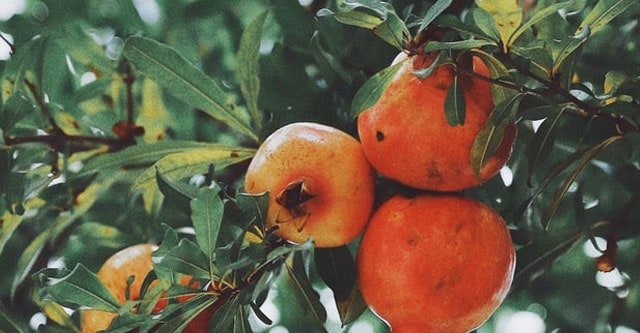Last Updated on January 6, 2021 by Dr Sharon Baisil MD
Pomegranate is a well-known fruit all over the world.
According to different areas of India, it has got different names such as ‘Anar’ in Hindi and Punjabi, ‘Danimma’ in Telugu,’ Maathalan Rakam’ in Malayalam, ‘Dalimba’ in Marathi, ‘Dalim’ in Bengali, etc.
What is the Glycemic Index of Pomegranate?

A glass of chilled pomegranate juice will refresh you on a hot summer noon. This juice may be considered a nutrition bomb. The glycemic index of pomegranate is 54, which belongs to the low glycemic category, and makes it a safe option for people with Diabetes.
Diabetes results from dysfunction of the metabolic and endocrine systems. Here, the pancreas is either diseased or autoimmune to itself. So it can not produce enough insulin, or the cells of the body become resistant to insulin.
Insulin is the key to the door of the cells. As the problem lies in insulin, the glucose is stagnant in the blood and raises blood glucose levels.
A diet with foods that will supply less glucose and more fiber, proteins, fat, vitamins can control the high blood sugar in diabetes.
Glycemic index is a number that determines the speed of blood glucose elevation after a carbohydrate-containing meal compared to glucose or white bread. It mainly focuses on the type and quality of carbohydrates.
There are some ranges-
- 0-55(low)
- 56-69(moderate)
- 70 or over(high)
The foods that are easily digestible and absorbable can raise blood glucose rapidly. Foods containing more fiber, protein, fats are less easily available to the digestive tract. So they will not negatively affect blood glucose.
Although the sugar content of this fruit is notably high, it is safe for diabetics.
Pomegranate is a known source of potent fibers. These fibers will prevent blood sugar from excess elevation. So the lower glycemic index of pomegranate is a pretty good sign to make it suitable for diabetics.
What is the Glycemic load of Pomegranate?
The glycemic load of pomegranate is about 18. It is in the moderate category. Glycemic load measures the number of carbohydrates along with the glycemic index value.
There are also some ranges-
- 0-10(low)
- 11-19(moderate)
- 20 or over(high)
Is Pomegranate Safe for Diabetes? 12 Health Benefits
In ayurvedic and Unani medicine, both the seeds and the juice are used as a tonic to improve blood sugar in diabetic persons.
Though there is a lack of scientific evidence regarding pomegranate’s diabetic benefits, it is used traditionally in the Middle East and India for diabetes control.
1. Blood glucose lowering effect: The glycemic index is one of the factors in the blood-glucose-lowering mechanism.
Apart from this, the sugars in pomegranate are engaged with antioxidants. This property makes them unique and helps to reduce blood glucose.
2. Prevent chronic inflammation:
Lowering the glycemic index can only cause slow digestion of carbs and slow glucose release in the blood.
Pomegranate gives benefits to the diabetics mainly by reducing oxidative stress than by lowering the overall glycemic index.
Among the antioxidants, punicalagin and punicic acid are the most efficacious to reduce blood glucose levels. They make pomegranates 3 times richer in antioxidants than red wine and green tea.
Diabetes is the result of a chronic inflammatory process. These two compounds can fight free radicals and prevent oxidative stress.
This, in turn, helps to prevent cell damage. In this way, chronic inflammation is prevented.
3. Improve insulin sensitivity: Pomegranate juice effectively improves the functions of pancreatic beta cells to produce more insulin.
Also, it has some phytochemicals such as tannins, gallic acid, etc. These can fight insulin resistance and improve insulin sensitivity.
Diabetes-related obesity can also be prevented by reducing insulin resistance.
4. Reduce bad cholesterol(LDL): Cholesterol-lowering is another indirect way to improve the condition of diabetics. Heart disease and strokes are common complications of diabetes.
Atherosclerosis or hardening of arteries is caused by excess accumulation of LDL cholesterol in the arteries.
This increases the chance of cardiovascular disease, one of the most leading causes of death from diabetic complications.
Taking pomegranate in the right way can reduce bad cholesterol content without affecting the HDL or good cholesterol.

Most of the benefits are due to the presence of a huge amount of potent antioxidants.
5. Anti-inflammatory: Cardiovascular diseases, cancer, joint pain, some brain diseases are the outcome of inflammation.
This anti-inflammatory property is mediated by the punicalagin compounds present in the pomegranate. They fight with free radicals and keep the cells free from destruction.
6. Inhibitory to the growth of cancer cells: There is some evidence that proves pomegranate’s capability to stop the growth of prostate and breast cancer cells.
Though these statements are still under observation, the antioxidant compounds’ anti-inflammatory criteria are possibly responsible for this.
7. Control blood pressure and heart disease: Pomegranate has low sodium and high potassium contents that control blood pressure up to a certain range. Regular eating of the juice may reduce blood pressure within 2 weeks.
High blood pressure is one of the risk factors for cardiovascular diseases. Also, atherosclerosis of arteries can be a major risk factor. Pomegranates can drive away all of them.
8. Reduce joint pain: Joint pains, as in arthritis, are mostly due to inflammation. As I’ve mentioned, pomegranate is rich in different antioxidants; it can surely work as a pain reliever.
9. Improve memory: The antioxidants of the pomegranate can improve memory. Through this function, regular eating of a certain portion of pomegranate may improve Alzheimer’s patients’ memory.
10. Solve infertility: Any infection causes oxidative damage and impaired blood flow to different organs. This may result in erectile dysfunction, diseased sperms, and even decreased fertility in females.
The antioxidant components of pomegranate juice can overcome this stress, and infertility related problems may be solved. It may also improve sex drives in both men and women.
11. Immunity booster: The vitamin and mineral contents of pomegranate help improve immunity by dealing with active infections.
Vitamin C and vitamin E are the most efficacious in this context. It may act against bacteria, viruses, fungus, etc.
12. Recover body after exercise and sports: Along with the beet and tart, pomegranate may also be used as a recovery food.
It has special nitrate content, which makes it able to reduce muscle soreness and regain strength.
Besides these, the anti-inflammatory action may keep digestive tract related problems at bay.
What are the Side Effects of eating Pomegranate?

Allergies: Some persons are hypersensitive to pomegranate extract and may produce some symptoms like rash, itching, runny nose, breathing difficulty, etc.
Low blood pressure: As pomegranate has the capacity to reduce blood pressure, it may cause adverse effects to those who already have issues with low blood pressure.
There is a chance of low blood pressure after surgery. So try to avoid pomegranate in the perioperative period.
Research findings of the Diabetic Benefits of Pomegranate
★ A human trial suggested that regular drinking of pomegranate juice may decrease the blood sugar level by improving beta cells’ functions.
★ Some Jordan University of Science and Technology scientists examined that drinking pomegranate juice regularly at a dose of 1.5 ml per kg body weight(150 ml for 70 kg person) may notably reduce fasting blood sugar in type-2 diabetics.
★ The Egyptian Journal of Hospital Medicine published a study about the pomegranate peel aqueous extract’s potential to reduce blood sugar by regeneration of beta cells.
★ A study in diabetics was done for a long duration (12 weeks) to see the effects of drinking 1.1cup(250ml) of pomegranate juice a day. It revealed the reduction of inflammatory markers CRP and interleukin-6 by 32% and 30%, respectively.
What are the Nutrition Facts of Pomegranate?

| Pomegranates, Raw: Nutrition Information | |||
| # Serving size 100 g | |||
| Nutrient | Amount | Unit | DV |
| Calories | 83 | KCAL | |
| Fat | 1.17 | G | 2% |
| Protein | 1.67 | G | 3% |
| Carbohydrate | 18.7 | G | 7% |
| Folic acid | 0 | UG | |
| Caffeine | 0 | MG | |
| Theobromine | 0 | MG | |
| Vitamin E | 0.6 | MG | 3% |
| Vitamin D (D2 + D3), International Units | 0 | IU | |
| Choline | 7.6 | MG | |
| Campesterol | 1 | MG | |
| Saturated fatty acids | 0.12 | G | 1% |
| Ash | 0.53 | G | |
| Fiber | 4 | G | 14% |
| Iron, Fe | 0.3 | MG | 2% |
| Magnesium, Mg | 12 | MG | 3% |
| Phosphorus, P | 36 | MG | 5% |
| Sodium, Na | 3 | MG | 0% |
| Copper, Cu | 0.158 | MG | 18% |
| Manganese, Mn | 0.119 | MG | 5% |
| Vitamin C | 10.2 | MG | 11% |
| Thiamin | 0.067 | MG | 6% |
| Riboflavin | 0.053 | MG | 4% |
| Folate | 38 | UG | |
| Vitamin K | 16.4 | UG | 14% |
| Water | 77.93 | G | |
| Niacin | 0.293 | MG | 2% |
| Pantothenic acid | 0.377 | MG | 8% |
| Vitamin B6 | 0.075 | MG | 6% |
| Sugars | 13.67 | G | |
| Calcium, Ca | 10 | MG | 1% |
| Potassium, K | 236 | MG | 5% |
| Zinc, Zn | 0.35 | MG | 3% |
| Selenium, Se | 0.5 | UG | 1% |
| Stigmasterol | 0 | MG | |
| Beta-sitosterol | 4 | MG | |
| Monounsaturated fatty acids | 0.093 | G | |
| Polyunsaturated fatty acids | 0.079 | G | |
| Alcohol, ethyl | 0 | G | |
| Retinol | 0 | UG | |
| Octanoic acid | 0 | G | |
| Docosahexaenoic n-3 acid (DHA) | 0 | G | |
| Eicosapentaenoic n-3 acid (EPA) | 0 | G | |
| Docosapentaenoic n-3 acid (DPA) | 0 | G | |
| Vitamin A, RAE | 0 | UG | |
| Carotene, beta | 0 | UG | |
| Carotene, alpha | 0 | UG | |
| Cryptoxanthin, beta | 0 | UG | |
| Lycopene | 0 | UG | |
| Folate, food | 38 | UG | |
| Vitamin A | 0 | IU | 0% |
| Docosenoic acid | 0 | G | |
| Butanoic acid | 0 | G | |
| Hexanoic acid | 0 | G | |
| Decanoic acid | 0 | G | |
| Octadecatrienoic acid | 0 | G | |
| Eicosatetraenoic acid | 0 | G | |
| Octadecatetraenoic acid | 0 | G | |
| Lutein + zeaxanthin | 0 | UG | |
| Folate, DFE | 38 | UG | 10% |
| Fatty acids, total trans | 0 | G | |
| Eicosenoic acid | 0.004 | G | |
| Hexadecanoic acid | 0.07 | G | |
| Octadecanoic acid | 0.038 | G | |
| Octadecenoic acid | 0.077 | G | |
| Octadecadienoic acid | 0.079 | G | |
| Hexadecenoic acid | 0.012 | G | |
| Dodecanoic acid | 0.006 | G | |
| Tetradecanoic acid | 0.006 | G | |
| Cholesterol | 0 | MG | 0% |
| Vitamin B12 | 0 | UG | 0% |
| Vitamin B12, added | 0 | UG | |
| Vitamin E added | 0 | MG | |
| Vitamin D | 0 | UG | 0% |
| Tocopherol, alpha | 0.6 | MG | |
| Pomegranate Juice – Nutrition Information | |||
| # Serving size 100 mL | |||
| Nutrient | Amount | Unit | DV |
| Calories | 54 | KCAL | |
| Fat | 0.29 | G | 0% |
| Protein | 0.15 | G | 0% |
| Carbohydrate | 13.13 | G | 5% |
| Vitamin D | 0 | UG | 0% |
| Folate, DFE | 24 | UG | 6% |
| Vitamin D (D2 + D3), International Units | 0 | IU | |
| Sucrose | 0 | G | |
| Glucose (dextrose) | 6.28 | G | |
| Maltose | 0 | G | |
| Water | 85.95 | G | |
| Caffeine | 0 | MG | |
| Theobromine | 0 | MG | |
| Sugars | 12.65 | G | |
| Calcium, Ca | 11 | MG | 1% |
| Potassium, K | 214 | MG | 5% |
| Zinc, Zn | 0.09 | MG | 1% |
| Selenium, Se | 0.3 | UG | 1% |
| Vitamin E | 0.38 | MG | 2% |
| Vitamin E added | 0 | MG | |
| Butanoic acid | 0 | G | |
| Hexanoic acid | 0 | G | |
| Decanoic acid | 0 | G | |
| Hexadecanoic acid | 0.044 | G | |
| Octadecanoic acid | 0.024 | G | |
| Octadecenoic acid | 0.049 | G | |
| Octadecadienoic acid | 0.05 | G | |
| Octadecatrienoic acid | 0 | G | |
| Eicosatetraenoic acid | 0 | G | |
| Octadecatetraenoic acid | 0 | G | |
| Eicosenoic acid | 0.003 | G | |
| Docosenoic acid | 0 | G | |
| Monounsaturated fatty acids | 0.059 | G | |
| Polyunsaturated fatty acids | 0.05 | G | |
| Lutein + zeaxanthin | 0 | UG | |
| Niacin | 0.233 | MG | 1% |
| Pantothenic acid | 0.285 | MG | 6% |
| Vitamin B6 | 0.04 | MG | 3% |
| Choline | 4.8 | MG | |
| Folic acid | 0 | UG | |
| Ash | 0.49 | G | |
| Fructose | 6.37 | G | |
| Lactose | 0 | G | |
| Alcohol, ethyl | 0 | G | |
| Galactose | 0 | G | |
| Fiber | 0.1 | G | 0% |
| Iron, Fe | 0.1 | MG | 1% |
| Magnesium, Mg | 7 | MG | 2% |
| Phosphorus, P | 11 | MG | 2% |
| Sodium, Na | 9 | MG | 0% |
| Copper, Cu | 0.021 | MG | 2% |
| Manganese, Mn | 0.095 | MG | 4% |
| Vitamin A | 0 | IU | 0% |
| Retinol | 0 | UG | |
| Vitamin A, RAE | 0 | UG | |
| Carotene, beta | 0 | UG | |
| Carotene, alpha | 0 | UG | |
| Cryptoxanthin, beta | 0 | UG | |
| Lycopene | 0 | UG | |
| Vitamin C | 0.1 | MG | 0% |
| Thiamin | 0.015 | MG | 1% |
| Riboflavin | 0.015 | MG | 1% |
| Folate | 24 | UG | |
| Vitamin B12 | 0 | UG | 0% |
| Vitamin K | 10.4 | UG | 9% |
| Folate, food | 24 | UG | |
| Vitamin B12 added | 0 | UG | |
| Cholesterol | 0 | MG | 0% |
| Saturated fatty acids | 0.077 | G | 0% |
| Octanoic acid | 0 | G | |
| Dodecanoic acid | 0.004 | G | |
| Tetradecanoic acid | 0.004 | G | |
| Docosahexaenoic n-3 acid (DHA) | 0 | G | |
| Hexadecenoic acid | 0.008 | G | |
| Eicosapentaenoic n-3 acid (EPA) | 0 | G | |
| Docosapentaenoic n-3 acid (DPA) | 0 | G | |
| Fatty acids, total trans | 0 | G | |
| Tocopherol, alpha | 0.38 | MG | |
How many pomegranates can a diabetic eat per day?

1 medium to small whole pomegranate is enough in a day. In the case of juice, it may vary from 6-8 ounces(1 cup). Try to prefer fresh, homemade juice.
You should talk to your health care provider to determine the amounts.
What are the right ways of eating pomegranate for Diabetes?

The appropriate ways, timing, and amount of any food are significant in diabetic meal planning. You always need to think logically about the ways and timing.
- A person with diabetes should try to eat raw arils rather than juice. Juicing usually destroys the fiber content, which is essential.
- Mix it with other nuts and olives for further lowering of glycemic index
- Make a fruit salad using the low glycemic fruits. Add some pomegranate arils over them.
- Don’t use them for any cooking purposes. It is totally unwise and unscientific.
- Grind some whole cinnamon and flaxseeds. Sprinkle the powder over the fruit salad. This helps to balance blood sugar absorption.
- Fix a specific time for eating a pomegranate. Eat them in the mid-morning or evening snacks. It means that you should eat them in between meals.
- Consume them in moderation, though it is in the low glycemic category. You need not fill your tummy by eating a large amount of pomegranate.
Using the arils in a fruit salad is the best way for moderate consumption.
Conclusion
A whole day meal becomes completed by the presence of healthy and fresh fruits in them.
Pomegranate is usually found in all seasons. The varieties that are free from chemicals and pesticides should be preferred.
In a huge context, there are no major adverse effects of eating a pomegranate. So a diabetic can enjoy them without tension.
Several antioxidants are present in plenty of pomegranates. They cause the lowering of blood glucose both in direct and indirect ways.
All the vitamins, minerals, and antioxidants are anti-inflammatory in nature and prevent various acute and chronic inflammation.
These are necessary to prevent both the onset and pathway of type 2 diabetes.
You must continue your necessary medications and try to do some exercises.
References
- https://pubmed.ncbi.nlm.nih.gov/30317607/
- https://pubmed.ncbi.nlm.nih.gov/23953990/
- https://pubmed.ncbi.nlm.nih.gov/23684435/
- https://pubmed.ncbi.nlm.nih.gov/28867799/
- https://pubmed.ncbi.nlm.nih.gov/28425868/
- https://pubmed.ncbi.nlm.nih.gov/30677224/
- https://pubmed.ncbi.nlm.nih.gov/18590349/
- https://pubmed.ncbi.nlm.nih.gov/30661697/
- https://pubmed.ncbi.nlm.nih.gov/30945297/
- https://pubmed.ncbi.nlm.nih.gov/26742071/
- https://pubmed.ncbi.nlm.nih.gov/31632524/





